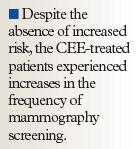- Safety & Recalls
- Regulatory Updates
- Drug Coverage
- COPD
- Cardiovascular
- Obstetrics-Gynecology & Women's Health
- Ophthalmology
- Clinical Pharmacology
- Pediatrics
- Urology
- Pharmacy
- Idiopathic Pulmonary Fibrosis
- Diabetes and Endocrinology
- Allergy, Immunology, and ENT
- Musculoskeletal/Rheumatology
- Respiratory
- Psychiatry and Behavioral Health
- Dermatology
- Oncology
Estrogen alone does not raise risk of breast cancer in hysterectomy patients
Postmenopausal women with prior hysterectomies do not increase their risk of breast cancer incidence with the use of conjugated equine estrogen (CEE), according to a study published in the Journal of the American Medical Association (JAMA).

The study analyzed data from a prematurely terminated Women's Health Initiative (WHI) report. The Estrogen-Alone trial, which compared CEE and placebo use in 10,739 postmenopausal women aged 50 to 79 years, was halted in February 2004 because of increased stroke incidence and no reduction of coronary heart disease.
A mean follow-up of 7.1 years showed that the invasive breast cancer hazard ratio for women assigned to 0.625 mg/d of CEE versus identical-appearing placebo was 0.80 (95% CI, 0.62–1.04; P=.09). The annualized rates were 0.28% (104 cases in the CEE group) and 0.34% (133 cases in the placebo group).
In exploratory analyses, ductal carcinomas were reduced in the CEE group versus the placebo group (HR=0.71; 95% CI, 0.52–0.99), although the test for interaction by tumor type was not significant (P=.054).
"This result is in clear contrast to the WHI trial of CEE combined with medroxyprogesterone acetate in women with a uterus, which showed a significant increase in breast cancer incidence over a mean of 5.6 years of follow-up," the authors stated.
Despite the absence of increased risk, the CEE-treated patients experienced increases in the frequency of mammography screening. At 1 year, 9.2% of women in the CEE group had mammograms with abnormalities requiring follow-up, compared with 5.5% in the placebo group (P<.001). That pattern continued throughout the trial and reached a cumulative percentage of 36.2% versus 28.1%, respect-ively (P<.001).
Both the Estrogen-Alone trial and the E+P trial "showed substantial increases in the frequency of mammograms requiring follow-up from the first year onward," the authors stated. "However, this increase was seen only for recommended short-interval follow-up mammograms in the Estrogen-Alone trial, whereas it applied also to those with suspicious abnormality or highly suggestive of malignancy in the E+P trial."
The effect of CEE on breast cancer was seen in some subgroups that had lower Gail breast cancer risk estimates, which takes into account factors such as age, race, the number of first-degree relatives with breast cancer, and previous breast biopsies.
"Such findings suggest a strong influence of CEE on breast cancer not linked to family history and/or those less likely to be associated with microcalcification, a mammography finding that often leads to recommendation for breast biopsy," the authors stated.
Regarding differences between findings in the E+P and Estrogen Alone trials, the mean 5-year Gail breast cancer risk estimates were similar (1.6% in the Estrogen-Alone trial and 1.5% in the E+P trial). The annualized rates of invasive breast cancer also were similar for the placebo groups in the 2 trials (0.34% in the Estrogen-Alone trial and 0.33% in the E+P trial). "Thus, cross-study differences in the study cohorts do not explain the differences in breast cancer effects seen, and the results strongly suggest a role for progestin in relation to increasing breast cancer risk," the authors said.
In determining whether patients should consider CEE treatment, the authors stated that "initiation of CEE alone in women after hysterectomy should continue to be based on careful consideration of potential risks and benefits for a given individual."
SOURCE Stefanick ML, Anderson GL, Margolis KL, et al. Effects of conjugated equine estrogens on breast cancer and mammography screening in postmenopausal women with hysterectomy. JAMA. 2006;295:1647–1657.
